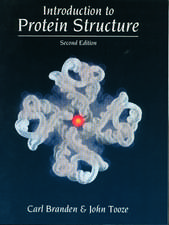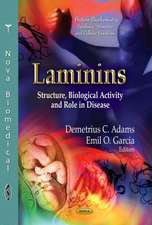Structural Biology of Membrane Proteins: RSC Biomolecular Sciences
David M.J. Lilley, Simon Campbell, Marius Clore Editat de Reinhard Grisshammer, Susan K. Buchananen Limba Engleză Hardback – 11 mai 2006
In the last few years there have been many exciting and innovative developments in the field of membrane protein structure and this trend is set to continue. Structural Biology of Membrane Proteins is a new monograph covering a wide range of topics with contributions from leading experts in the field. The book is split into three sections: the first discusses topics such as expression, purification and crystallisation; the second covers characterisation techniques and the final section looks at new protein structures. The book will hence have wide appeal to researchers working in and around the field and provide an up-to-date reference source. Introductory sections to each topic are accompanied by more detailed discussions for the more experienced biochemist. Detailed descriptions of experimental methods are included to demonstrate practical approaches to membrane protein structure projects. The book also offers an up-to-date reference source in addition to descriptions of new and emerging developments, including state-of-the-art techniques for solving membrane protein structures. Structural Biology of Membrane Proteins encompasses both basic introductions and detailed descriptions of themes and should appeal to a wide range of biochemical scientists, both experienced and beginner.
Din seria RSC Biomolecular Sciences
- 14%
 Preț: 1028.49 lei
Preț: 1028.49 lei - 14%
 Preț: 1123.82 lei
Preț: 1123.82 lei - 5%
 Preț: 1236.31 lei
Preț: 1236.31 lei - 14%
 Preț: 1129.77 lei
Preț: 1129.77 lei - 14%
 Preț: 1193.61 lei
Preț: 1193.61 lei - 14%
 Preț: 1029.33 lei
Preț: 1029.33 lei - 14%
 Preț: 1193.61 lei
Preț: 1193.61 lei - 27%
 Preț: 2006.97 lei
Preț: 2006.97 lei - 14%
 Preț: 1028.80 lei
Preț: 1028.80 lei - 14%
 Preț: 1029.45 lei
Preț: 1029.45 lei - 5%
 Preț: 1143.04 lei
Preț: 1143.04 lei - 14%
 Preț: 1030.44 lei
Preț: 1030.44 lei - 14%
 Preț: 1129.25 lei
Preț: 1129.25 lei - 14%
 Preț: 1127.10 lei
Preț: 1127.10 lei - 14%
 Preț: 1134.26 lei
Preț: 1134.26 lei - 9%
 Preț: 923.16 lei
Preț: 923.16 lei - 9%
 Preț: 923.25 lei
Preț: 923.25 lei - 9%
 Preț: 1006.97 lei
Preț: 1006.97 lei - 9%
 Preț: 922.68 lei
Preț: 922.68 lei - 9%
 Preț: 922.46 lei
Preț: 922.46 lei - 9%
 Preț: 1006.03 lei
Preț: 1006.03 lei
Preț: 1127.28 lei
Preț vechi: 1310.79 lei
-14% Nou
Puncte Express: 1691
Preț estimativ în valută:
215.77€ • 234.46$ • 181.37£
215.77€ • 234.46$ • 181.37£
Carte disponibilă
Livrare economică 31 martie-14 aprilie
Preluare comenzi: 021 569.72.76
Specificații
ISBN-13: 9780854043613
ISBN-10: 0854043616
Pagini: 392
Ilustrații: Illustrations (some col.)
Dimensiuni: 161 x 239 x 27 mm
Greutate: 0.76 kg
Editura: Royal Society Of Chemistry
Seriile RSC Biomolecular Sciences, RSC Biomolecular Sciences (unnumbered)
Locul publicării:United Kingdom
ISBN-10: 0854043616
Pagini: 392
Ilustrații: Illustrations (some col.)
Dimensiuni: 161 x 239 x 27 mm
Greutate: 0.76 kg
Editura: Royal Society Of Chemistry
Seriile RSC Biomolecular Sciences, RSC Biomolecular Sciences (unnumbered)
Locul publicării:United Kingdom
Cuprins
Part One: Expression and Purification of Membrane Proteins; Chapter 1: Refolding of G-protein-coupled receptors; 1: Introduction; 2: Refolding of membrane proteins; 3: In vitro protein refolding; 4: GPCR in vitro refolding; 5: Conclusion; 6: References; Chapter 2: Expression of genes encoding eukaryotic membrane proteins in mammalian cells; 1: Introduction; 2: Mammalian cell hosts and gene expression vectors; 3: Delivery and maintenance of expression vectors in mammalian host cells; 4: Use of HEK293S stable cell lines for high-level expression of eukaryotic membrane proteins; 5: Large-scale growth of HEK293S stable cell lines in suspension culture using a bioreactor and inducible gene expression; 6: Preparation of eukaryotic membrane proteins containing simple N-glycans; 7: Outlook for use of HEK293S tetracycline-inducible cell lines for large-scale preparation of other eukaryotic membrane proteins; Chapter 3: Expression of recombinant G-protein-coupled receptors for structural biology; 1: Introduction; 2: Expression of recombinant GPCRs; 3: Conclusions; 4: References; Chapter 4: The purification of G-protein-coupled receptors for crystallization; 1: Introduction; 2: Heterogeneity of overexpressed receptors; 3: Membrane fractionation, solubilization and detergent selection; 4: Purification; 5: Final quality control, monitoring protein stability, aggregational state, lipid and bound detergent; 6: Conclusions; Chapter 5: An introduction to detergents and their use in membrane protein studies; 1: Introduction; 2: Physical properties of detergents used in membrane protein studies; 3: Extraction and purification procedure using common detergents; 4: Use of detergents in membrane protein crystallization; 5: Conclusion; 6: References; Part Two: Methods for Structural Characterization of Membrane Proteins; Chapter 6: Solution NMR approaches to the structure and dynamics of integral membrane proteins; 1: Introduction; 2: Protein production and optimization for NMR studies; 3: NMR methodology for the study of integral membrane proteins; 4: Solution NMR structures of helical integral membrane proteins; 5: Solution NMR Structures of ?-barrel membrane proteins; 6: Solution NMR characterization of membrane protein dynamics; 7: Future directions; 8: References; Chapter 7: Membrane proteins studied by solid-state NMR; 1: Introduction; 2: Sample preparation and methodology; 3: Applications; 4: Conclusions; 5: References; Chapter 8: Assessing structure and dynamics of native membrane proteins; 1: Introduction; 2: Assembly of 2D crystals; 3: Electron microscopy; 4: Atomic force microscopy; 5: Conclusion and perspectives; Chapter 9: State-of-the-art methods in electron microscopy, including single particle analysis; 1: Introduction; 2: Sample Preparation; 3: Low Dose Microscopy; 4: Applications of CryoEM; 5: Examples; 6: Conclusion; Chapter 10: Atomic resolution structures of integral membrane proteins using cubic lipid phase crystallization; 1: Introduction; 2: Membrane protein crystals & crystallization; 3: Advantages of structures in a native setting at high resolution; 4: Conclusions; 5: References; Part Three: New Membrane Protein Structures; Chapter 11: Aquaporins: Integral membrane channel proteins; 1: Introduction; 2: Aquaporin channel proton exclusion barrier; 3: Selectivity in the aquaporin family; 4: Permeation by substances other than water and glycerol; 5: Aquaporin monomer associations and their functional implications; 6: References; Chapter 12: Gas channels for ammonia; 1: Introduction; 2: The structure of Ammonia Channel; 3: Reconstituted into liposomes AmtB acts as a channel that conducts NH3; 4: The Mechanism of conduction; 5: The Rh proteins; 6: Comparison with AQPs; 7: Comparison with K+ channel; 8: Acknowledgement; 9: References; Chapter 13: Channels in the outer membrane of Mycobacter; 1: Introduction; 2: Structure determination; 3: Structure description; 4: The outer membrane; 5: Conclusion; 6: References; Chapter 14: The structure of the SecY protein translocation channel; 1: Abstract; 2: Introduction; 3: Structure determination of the SecY complex by electron cryo-microscopy; 4: Determination of the X-ray crystal structure of the SecY complex; 5: Description of the structure of the SecY complex; 6: Post-translational translocation in bacteria; 7: Conclusions and outlook; 8: References; Chapter 15: Structure and function of the translocator domain of bacterial autotransporters; 1: Introduction; 2: The NalP autotransporter; 3: The translocator domain of autotransporters; 4: Purification and in vitro folding of the NalP translocator domain; 5: The structure of the NalP translocator domain; 6: Comparison of the NalP translocator domain to other translocator domains and to TolC; 7: The autotransporter secretion mechanism; Chapter 16: X-ray crystallographic structures of sarcoplasmic reticulum Ca2+-ATPase at the atomic level; 1: Introduction; 2: The transport scheme and thermodynamics of Ca2+ transport; 3:::::: Overall structure of Ca2+-ATPase; 4: Transport models; 5: Initialization of the cycle - phosphorylation and calcium ion occlusion; 6: The dephosphorylation step and proton counter transport; 7: Getting Ca2+ in and out of the membrane; 8: Compact versus open conformations of SERCA; 9: Conclusions; Chapter 17: Comparison of the multidrug transporter EmrE structures determined by electron cryo-microscopy and X-ray crystallography; 1: Introduction; 2: The oligomeric state of EmrE; 3: Transport activity of EmrE; 4: Structure of EmrE determined by electron cryomicroscopy; 5: Comparison of the EmrE structure determined by electron crystallography with a 3.8 Å resolution structure determined by X-ray crystallography; 6: Conclusion; 7: References; Chapter 18: Structure of photosystems I and II; 1: Introduction to oxygenic photosynthesis; 2: Photosystem ii; 3: Photosystem I; 4: Conclusion and outlook; Chapter 19: Glutamate receptor ion channels - Structural insights into molecular mechanism; 1: Introduction; 2: Studies of the Ligand-binding Domain; 3: The Functional Architecture of a Glutamate Receptor Ion Channel; 4: A Working Model of AMPA Receptor Function; 5: Open Questions; 6: References; Chapter 20: The mitochondrial ADP/ATP carrier; 1: Introduction; 2: Mitochondrial carriers and ADP/ATP carrier; 3: Crystallization; 4: Diffraction, phasing and model building; 5: Structure analysis; 6: Functional implications; 7: Future developments and conclusions;
Recenzii
...an up-to-date account of the state of the art in this field....a snapshot of the state of the art in the structural biology of membrane proteins. This book fills a gap and can serve both the membrane-protein researcher who is interested in other methods as well as other scientists who wish to get a general overview of the current state of membrane-protein structural biology. A very well presented and informative account of structural biology of membrane proteins.
Textul de pe ultima copertă
In the last few years there have been many exciting and innovative developments in the field of membrane protein structure and this trend is set to continue. Structural Biology of Membrane Proteins is a new monograph covering a wide range of topics with contributions from leading experts in the field. The book is split into three sections: the first discusses topics such as expression, purification and crystallisation; the second covers characterisation techniques and the final section looks at new protein structures. The book will hence have wide appeal to researchers working in and around the field and provide an up-to-date reference source. Introductory sections to each topic are accompanied by more detailed discussions for the more experienced biochemist. Detailed descriptions of experimental methods are included to demonstrate practical approaches to membrane protein structure projects. The book also offers an up-to-date reference source in addition to descriptions of new and emerging developments, including state-of-the-art techniques for solving membrane protein structures. Structural Biology of Membrane Proteins encompasses both basic introductions and detailed descriptions of themes and should appeal to a wide range of biochemical scientists, both experienced and beginner.
Notă biografică
Reinhard Grisshammer has studied the structure and function of G-protein-coupled receptors during the past 15 years, establishing a bacterial expression system for production of these eukaryotic membrane proteins, and developing a large-scale purification procedure for obtaining milligram quantities of homogeneous, functional receptors for structural studies.
Susan Buchanan has studied bacterial outer membrane proteins that transport iron and other small or large molecules during the past 10 years, developing methods for high level expression, purification, and crystallization, followed by structure determination by X-ray crystallography.
Descriere
The book provides up-to-date reference source for researchers. Introductory sections to each topic are followed by detailed discussions for the experienced biochemist.














